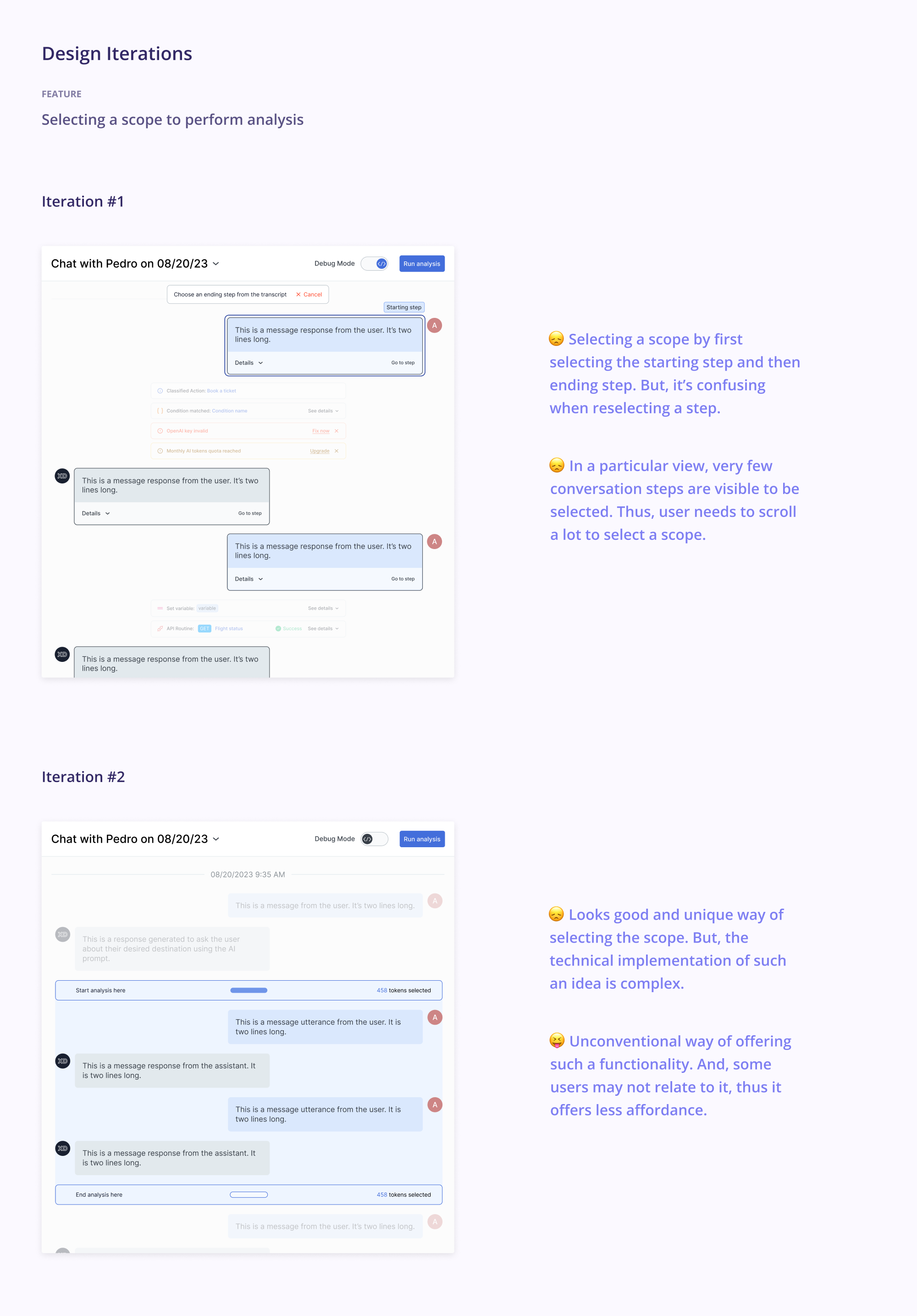
AI-Driven Transcript Analysis
VoiceXD
VoiceXD is a collaborative platform for building custom conversational AI assistants. When I joined the team in 2023, the platform was in Beta, supporting only the building and publishing of AI assistants. I first helped them launch the transcripts feature for conversation analysis, and then enhanced it with AI capabilities.
Responsibilities
Roadmap planning, Interaction Design, Prototyping, Cross-functional collaboration, User Testing
Team
1 UX Designer, 2 Software Engineers, 1 Product Manager
Overview
After the Beta release of the transcripts feature, it was now time for the General Availability (GA) release with enhanced AI capabilities.
We had scoped out certain features as per priority, and it was time to implement other priority features which are crucial for transcript analysis. Using AI for performing the analysis was the top priority. We wanted the users to come to VoiceXD and have a unified experience for building, publishing and analyzing conversational experiences.
My Role
I was responsible for defining the project scope, discovering user pain points, prototyping, user testing solutions and the final developer handoff.
Experience strategy and insights
Uncovered customer insights with my Manager and defined a priority-based feature stack for VoiceXD. Also handled user queries and suggestions to bring notable updates to the platform.
Design
Translated the business goals and user pain points into effective design ideas, using the existing platform as an anchor. Also designed interactive prototypes based on the user flow for transcript analysis.
Cross-functional collaboration
Partnered with our Tech Lead to identify constraints and opportunities with OpenAI's APIs to leverage their functionality effectively. Also worked to handle edge cases specific to the APIs responsible for transcript analysis.
Developer handoff
Created a reusable component system which can be later integrated into VoiceXD's design system. This made the developer handoff smooth and a new process was established which didn't exist before.
Current state of Transcripts
Users can collaboratively analyze conversation transcripts in a scalable and organized manner, with the option for detailed analysis.

What was the problem?
Users need to manually scan the conversation transcripts to extract insights, and scroll all the way up and down to read each message and understand the context of the conversation while being overwhelmed by the information.
How did we address?
Allowing users to use AI to run analysis and refine their Conversational Assistants, from identifying improvement areas in past conversations to gathering actionable insights, all in a collaborative, scalable and efficient manner.
Exploring Possible Solutions
Initial solution involved utilizing the existing sidebar to incorporate the analysis functionality. However, based on the insights gathered from user testing, we had to pivot.


Major Takeaway #1
Our backend was designed to consider OpenAI's APIs which had a context limit, and thus if the input exceeds the limit, users wouldn't be able to perform the analysis. Thus, we now have to allow users to select a scope within the conversation to perform the analysis.
Major Takeaway #2
We decided to keep the 'Log Analysis' and 'Notes' functionality on the back burner because we didn't receive strong validation regarding their actual usefulness from the users and we were very much focused on the conversation analysis and didn't want to dilute that.
Addressing feedback
This feature was new to the CUI domain, thus I explored multiple out-of-box concepts which addressed the user requirements.
After the user testing, we understood that we had overwhelmed users with multiple features and they wanted a simpler way of performing analysis. Thus, we decided to table the 'Log Analysis' and 'Notes' functionality for later and focus solely on the conversation analysis functionality.

Final Solution
After exploring multiple design ideas, receiving simultaneous feedback from the engineering team and validating them, I finalize the designs.
We initially planned to allow users to select a scope withing the conversation to perform the prompt-based analysis, however after user testing, we identified that users might want to see the selected scope at a glance, or quickly reselect the scope. Thus, offering the users with the scope selection functionality in a modal where we planned to offer the run analysis functionality was finalized.

Here's a Bonus!
A glimpse of the reusable components created to help design and iterate faster.

The impact of my work
Transcript Analysis was successfully shipped to 500+ users across the globe in late 2023.
We have now created a space to seamlessly analyze conversation transcripts, without complicating the existing transcripts. Empathy for the win!
Increased functionality and overall upgrade
VoiceXD could now be used to analyze the conversations between the assistants and people, and gather actionable insights in an efficient manner.
Hand-offs to developers made easy
My manager described the design hand-off to developers as "smooth" and "exceeding expectations" considering my role as an intern.
Learnings and reflections
For me, transcript analysis was one of the most exciting projects to work on.
While I harboured an interest in interaction design, and had delved a fair bit into designing for AI, getting my hands dirty raised the bar on my learnings.
Working in a small agile team
Working in sprints in a cross functional team of 4 meant high accountability, speedy decision-making and frequent influx of information to iterate with.
Designing for the new CUI design user
Building feature for users who have limited exposure to CUI design requires a designer to simplify the experience to the last pixel.
Working with tech constraints
How to work with a complex architecture and a non-defined design system to build a solution that is user friendly and effective.
Navigating ambiguity
Develop well-defined and informed hypotheses, and then validate them early through in-depth conversations with users and stakeholders.